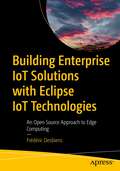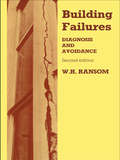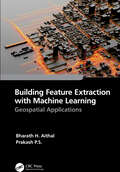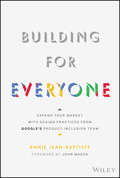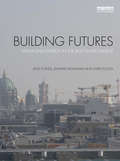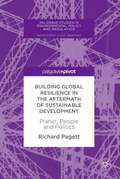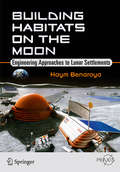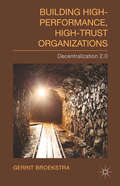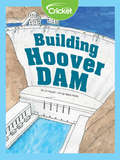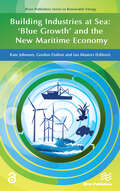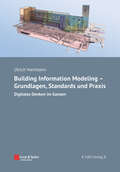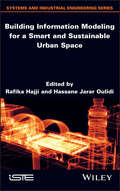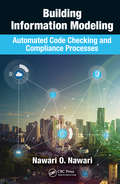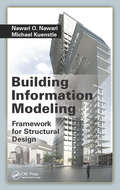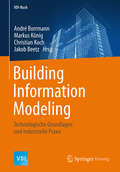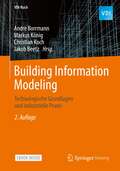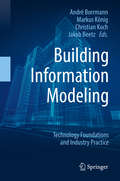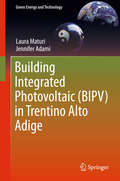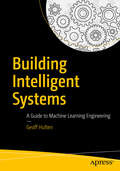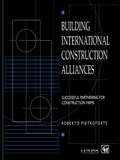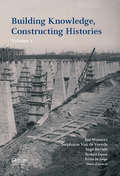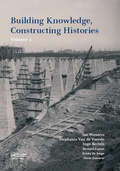- Table View
- List View
Building Enterprise IoT Solutions with Eclipse IoT Technologies: An Open Source Approach to Edge Computing
by Frédéric DesbiensBuild IoT solutions for the enterprise using open-source building blocks from the Eclipse IoT Working Group at the Eclipse Foundation. This book introduces you to key protocols and their implementations, such as CoAP (Eclipse Californium), DDS (Eclipse Cyclone DDS), LwM2M (Eclipse Leshan), and MQTT (Eclipse Paho, Eclipse Mosquitto, and Eclipse Amlen). You will learn about Edge Computing platforms (Eclipse ioFog, Eclipse Kanto), IoT gateways (Eclipse Kura, Eclipse Kapua), and next-generation edge native protocols (Eclipse zenoh).The book also covers production-ready platforms for digital twins (Eclipse Ditto), energy management (Eclipse VOLTTRON), contactless payments (Eclipse Keyple), and much more.Although the book discusses hardware matters, its focus is on software and relevant open standards. The book helps you understand the pros and cons of the technologies available from Eclipse IoT and how they have been used in actual deployments. The examples provided cover a variety of use cases, such as industrial automation, smart agriculture, digital buildings, robotics, and others.The book's contents follow a reference architecture encompassing constrained devices (things), edge devices (gateways, servers), and IoT Cloud platforms. For each of those three pillars, you will learn about relevant open-source components. Usage of code libraries and frameworks is explained through code samples. You will also learn how to deploy and configure platform-type components and how to leverage them. Special attention will be paid to security and edge computing throughout the book. What You Will LearnDescribe in your own words the main software components required in an IoT architectureSelect the appropriate IoT protocols, components, frameworks, and platforms for a specific projectEvaluate the connectivity options at your disposal and select the most appropriate onesExplain the value of business models focused on open-source components and deploy such models in your organizationDetermine if edge computing is relevant to a project and deploy the relevant components on an edge computing platformBuild Enterprise IoT solutions leveraging an array of open-source components and platforms using popular languages such as C, Java, and RustWho This Book Is ForDevelopers new to enterprise IoT who want to learn about fundamental technologies for that market segment and seek an introduction to relevant, open-source building blocks; experienced IoT developers who seek alternatives to the proprietary platforms they are currently using; software architects designing IoT solutions who want to understand open-source technology options
Building Failures: Diagnosis and avoidance
by W. H. RansomIn recent years building failures and the resulting lawsuits and awards for damages have frequently been in the news. The biggest headlines may have been reserved for structural failures and complete collapses, but we should not forget the less newsworthy failures such as leaky roofs, damp walls, dropped foundations and rotted timber. This book gives practical guidance on the prevention of failure by describing the nature and cause of the most common defects in buildings, and then shows how they should be avoided in design and construction.
Building Feature Extraction with Machine Learning: Geospatial Applications
by Bharath.H. Aithal Prakash P.S.Big geospatial datasets created by large infrastructure projects require massive computing resources to process. Feature extraction is a process used to reduce the initial set of raw data for manageable image processing, and machine learning (ML) is the science that supports it. This book focuses on feature extraction methods for optical geospatial data using ML. It is a practical guide for professionals and graduate students who are starting a career in information extraction. It explains spatial feature extraction in an easy-to-understand way and includes real case studies on how to collect height values for spatial features, how to develop 3D models in a map context, and others. Features Provides the basics of feature extraction methods and applications along with the fundamentals of machine learning Discusses in detail the application of machine learning techniques in geospatial building feature extraction Explains the methods for estimating object height from optical satellite remote sensing images using Python Includes case studies that demonstrate the use of machine learning models for building footprint extraction and photogrammetric methods for height assessment Highlights the potential of machine learning and geospatial technology for future project developments This book will be of interest to professionals, researchers, and graduate students in geoscience and earth observation, machine learning and data science, civil engineers, and urban planners.
Building For Everyone: Expand Your Market With Design Practices From Google's Product Inclusion Team
by Annie Jean-BaptisteDiversity and Inclusion to build better products from the front lines at Google Establishing diverse and inclusive organizations is an economic imperative for every industry. Any business that isn’t reaching a diverse market is missing out on enormous revenue potential and the opportunity to build products that suit their users' core needs. The economic “why” has been firmly established, but what about the “how?” How can business leaders adapt to our ever-more-diverse world by capturing market share AND building more inclusive products for people of color, women and other underrepresented groups? The Product Inclusion Team at Google has developed strategies to do just that and Building For Everyone is the practical guide to following in their footsteps. This book makes publicly available for the first time the same inclusive design process used at Google to create user-centric award-winning and profitable products. Author and Head of Product Inclusion Annie Jean-Baptiste outlines what those practices look like in industries beyond tech with fascinating case studies. Readers will learn the key strategies and step-by-step processes for inclusive product design that limits risk and increases profitability. Discover the questions you should be asking about diversity and inclusion in your products for marketers, user researchers, product managers and more. Understand the research the Product Inclusion team drove to back up their practices Learn the “ABCs of Product Inclusion” to build inclusion into your organization’s culture Leverage the product inclusion suite of tools to get your organization building more inclusively and identifying new opportunities. Read case studies to see how product inclusion works across industries and learn what doesn't work. Building For Everyone will show you how to infuse your business processes with inclusive design. You’ll learn best practices for inclusion in product design, marketing, management, leadership and beyond, straight from the innovative Google Product Inclusion team.
Building Futures: Managing energy in the built environment
by Jane Powell Jennifer Monahan Chris FouldsA reduction in the energy demand of buildings can make a major contribution to achieving national and international carbon reduction goals, in addition to addressing the interlinked issues of sustainable development, fuel poverty and fuel security. Despite improvements in thermal efficiency, the energy demand of buildings stubbornly remains unchanged, or is only declining slowly, due to the challenges posed by growing populations, the expectations of larger, more comfortable and better equipped living spaces, and an expanding commercial sector. Building Futures offers an interdisciplinary approach to explore this lack of progress, combining technical and social insights into the challenges of designing, constructing and operating new low energy buildings, as well as improving the existing, inefficient, building stock. The twin roles of energy efficiency, which is predominantly concerned with technological solutions, and energy conservation which involves changing peoples’ behaviour, are both explored. The book includes a broad geographical range and scale of case studies from the UK, Europe and further afield, including Passivhaus in Germany and the UK, Dongtan Eco City in China and retrofit houses in Denmark. This book is a valuable resource for students and academics of environmental science and energy-based subjects as well as construction and building management professionals.
Building Global Resilience in the Aftermath of Sustainable Development: Planet, People and Politics (Palgrave Studies in Environmental Policy and Regulation)
by Richard PagettThis book explains why the concept of sustainable development needs to be consigned to history. Using examples from around the world, Richard Pagett illustrates how so-called sustainable development has simply been a cul-de-sac, condemning millions to continuing extreme poverty. Building Global Resilience in the Aftermath of Sustainable Development highlights the futility of current governance systems in meeting modern day global challenges. It also explains the changes that are necessary for a more just and equitable economic societal model, with planetary limits at its core, to further the resilience of communities and society at large. These changes are crucial to confronting the existential threats posed by climate change, resource depletion and overpopulation. This book will be of particular interest to practitioners of environmental management and to anyone concerned for the future of the planet.
Building Green Skyscrapers (Fountas & Pinnell LLI Purple #Level V)
by Mary ReidPeople need skyscrapers. They hold hundreds of apartments and offices on a small piece of land. Instead of spreading homes, office buildings, and parking lots over acres of forest or prairie, skyscrapers leave much more of the natural world untouched.
Building Habitats on the Moon: Engineering Approaches to Lunar Settlements (Springer Praxis Books)
by Haym BenaroyaDesigning a habitat for the lunar surface? You will need to know more than structural engineering. There are the effects of meteoroids, radiation, and low gravity. Then there are the psychological and psychosocial aspects of living in close quarters, in a dangerous environment, far away from home. All these must be considered when the habitat is sized, materials specified, and structure designed. This book provides an overview of various concepts for lunar habitats and structural designs and characterizes the lunar environment - the technical and the nontechnical. The designs take into consideration psychological comfort, structural strength against seismic and thermal activity, as well as internal pressurization and 1/6 g. Also discussed are micrometeoroid modeling, risk and redundancy as well as probability and reliability, with an introduction to analytical tools that can be useful in modeling uncertainties.
Building Hawaii’s Innovation Economy: Summary of a Symposium
by Charles W. WessnerResponding to the challenges of fostering regional growth and employment in an increasingly competitive global economy, many U. S. states and regions have developed programs to attract and grow companies as well as attract the talent and resources necessary to develop innovation clusters. These state and regionally based initiatives have a broad range of goals and increasingly include significant resources, often with a sectoral focus and often in partnership with foundations and universities. These are being joined by recent initiatives to coordinate and concentrate investments from a variety of federal agencies that provide significant resources to develop regional centers of innovation, business incubators, and other strategies to encourage entrepreneurship and high-tech development. Building Hawaii's Innovation Economy: Summary of a Symposium explains the study of selected state and regional programs in order to identify best practices with regard to their goals, structures, instruments, modes of operation, synergies across private and public programs, funding mechanisms and levels, and evaluation efforts. This report reviews selected state and regional efforts to capitalize on federal and state investments in areas of critical national needs. Building Hawaii's Innovation Economy also reviews efforts to strengthen existing industries as well as specific new technology focus areas such as nanotechnology, stem cells, and energy in order to better understand program goals, challenges, and accomplishments.
Building High-Performance, High-Trust Organizations: Decentralization 2.0
by Gerrit BroekstraSome vanguard companies have evolved to a higher level of decentralization originating in the enabling-and-autonomy paradigm. A new kind of deep leadership is practiced by these spirit-driven organizations. This book brings together theory and case studies to cover historical origins and developments of both types of decentralization.
Building Hoover Dam
by Liz HuyckHave you ever wondered how the Hoover Dam was built? Follow along as the Colorado River itself tells you its story! A lot of work went into the construction of this giant dam, but it was worth it—we now have Lake Mead and a way of converting the river’s energy into electricity!
Building Industries at Sea - ‘Blue Growth’ and the New Maritime Economy
by Kate Johnson Gordon Dalton Ian MastersThroughout the world there is evidence of mounting interest in marine resources and new maritime industries to create jobs, economic growth and to help in the provision of energy and food security. Expanding populations, insecurity of traditional sources of supply and the effects of climate change add urgency to a perceived need to address and overcome the serious challenges of working in the maritime environment. Four promising areas of activity for ‘Blue Growth’ have been identified at European Union policy level including Aquaculture; Renewable Energy (offshore wind, wave and tide); Seabed Mining; and Blue Biotechnology. Work has started to raise the technological and investment readiness levels (TRLs and IRLs) of these prospective industries drawing on the experience of established maritime industries such as Offshore Oil and Gas; Shipping; Fisheries and Tourism. An accord has to be struck between policy makers and regulators on the one hand, anxious to direct research and business incentives in effective and efficient directions, and developers, investors and businesses on the other, anxious to reduce the risks of such potentially profitable but innovative investments.The EU H2020 MARIBE (Marine Investment for the Blue Economy) funded project was designed to identify the key technical and non-technical challenges facing maritime industries and to place them into the social and economic context of the coastal and ocean economy. MARIBE went on to examine with companies, real projects for the combination of marine industry sectors into multi-use platforms (MUPs). The purpose of this book is to publish the detailed analysis of each prospective and established maritime business sector. Sector experts working to a common template explain what these industries are, how they work, their prospects to create wealth and employment, and where they currently stand in terms of innovation, trends and their lifecycle. The book goes on to describe progress with the changing regulatory and planning regimes in the European Sea Basins including the Caribbean where there are significant European interests. The book includes:• Experienced chapter authors from a truly multidisciplinary team of sector specialisms• First extensive study to compare and contrast traditional Blue Economy with Blue Growth• Complementary to EU and National policies for multi-use of maritime space
Building Information Modeling - Grundlagen, Standards und Praxis: Digitales Denken im Ganzen (Bauingenieur-Praxis)
by Ulrich HartmannEin durchgängiges Informations-Management beim Planen, Bauen und Betreiben von Bauwerken ist der Grundgedanke von Building Information Modeling (BIM) und zentraler Bestandteil der Digitalisierung im Bauwesen. Das Buch erklärt gewerkeübergreifend die technischen Grundlagen und führt in die auf den ersten Blick komplizierte Begriffswelt ein. Auf alle aktuellen BIM-Normen von VDI, DIN oder ISO wird eingegangen und die praktische Relevanz erläutert. Mit einem praktischen Einstieg aus unterschiedlichen Perspektiven gelingt allen Akteuren der Einstieg in das digitale Miteinander. Das umfassende BIM-Buch aus der Praxis für die Praxis ist eine hervorragende Einführung ins digitale Neuland für alle Baugewerke und bietet gleichzeitig auch Fortgeschrittenen viele aktuelle Informationen.
Building Information Modeling for a Smart and Sustainable Urban Space
by Hassane Jarar Oulidi Rafika HajjiUrban spaces are being called upon to develop a capacity for resilience and sustainability in order to meet the major challenges they face. To achieve such a goal, a practical development framework must be implemented in order to take advantage of the technological innovations that characterize the field of construction and urban engineering. Today, multi-scale BIM is bringing about significant changes that are redefining the paradigms of urban management. It facilitates simulations of the sustainability of urban spaces with respect to several criteria; most notably relating to energy, the economy and the environment.Building Information Modeling for a Smart and Sustainable Urban Space proposes a theoretical and practical framework for implementing BIM models for the creation of sustainable and intelligent urban spaces. It addresses the issues of acquisition, modeling, interoperability, and BIM and GIS integration for the production of BIM models. Case studies are presented, providing a practical dimension that demonstrates the production process of the urban model and its contribution to multiscale simulations, particularly in real estate evaluation and urban renewal.
Building Information Modeling: Automated Code Checking and Compliance Processes
by Nawari Nawari"Many researchers and software developers have put a lot of effort into finding solutions for automated code checking. This book is a good summary of these efforts and provides readers with a comprehensive understanding of the status of such technologies in the industry. It also guides readers on implementation of such techniques using the platforms and tools currently available in the industry." — Issa Ramaji, University of North Florida, USA Building Information Modeling: Automated Code Checking and Compliance Processes covers current and emerging trends in automating the processes of examining building design against codes and standards of practice. The role of Building Information Modeling (BIM) technologies in these processes is thoroughly analyzed and explains how this new technology is significantly transforming modern architecture, engineering, and construction (AEC) domains. The book also introduces the theoretical background of computerizing compliance verification, including domain knowledge representations, building model representations, and automated code checking systems. An underlying goal for the material covered is to present the use of BIM technology as an integral part of the automated auditing process that can lead to a more comprehensive, intelligent, and integrated building design– a design where an optimized solution can be achieved in harmony with the current codes and standards of practice. This new proposed BIM-based framework for automating code conformance checking is one of the most powerful methods presently available to reflect actual building code requirements, and the methods described in the book offer significant benefits to the AEC industry such as: Providing consistency in interpretation of regulatory provisions Reducing code compliance validation errors, and the cost and time associated with compliance checking Allows for the ability to self-check required aspects before bidding Reduces the amount of time and resources required during design review Allows for optimal design, along with faster turnaround on feedback, and potentially faster approvals for construction permits by building and infrastructure authorities
Building Information Modeling: DIe Potenziale von BIM in der Anwendung (Transformation im Bauwesen)
by Prof. Dr.-Ing Jung-LundbergDie Notwendigkeit zur Applikation digitaler Methoden im Bauwesen wie Building Information Modeling (BIM) ist in den vergangenen Jahren erkannt worden. Baumaßnahmen sollen zukünftig erst virtuell und dann real gebaut werden. In diesem Kontext wurden in Deutschland bereits diverse BIM – Pilotprojekte durchgeführt. Im Fokus stehen dabei bislang primär Großprojekte. Für die angestrebte Digitalisierung der Baubranche sind jedoch auch die alltäglichen kleineren Projekte zu betrachten. Um eine Prüfung des potenziellen Nutzens von Building Information Modeling in dieser Sparte des Bauwesens zu ermöglichen, hat der Autor bereits 2019 ein entsprechendes Bewertungsmodell entwickelt. Dieses Fachbuch ist inhaltlich auf die Anwendbarkeit von BIM im Bereich ebensolcher Bauprojekte ausgerichtet. Es werden die wichtigsten Informationen zu BIM dargestellt. Anschließend werden anhand eines Praxisprojekts, welches parallel konventionell und BIM-basiert geplant wird, die Vorteile der BIM-Anwendung in kleineren Wohnungsbauvorhaben analysiert. Das Buch richtet sich an Ingenieure und Architekten in kleineren Planungsbüros und an alle BIM interessierten Akteure der Bauwirtschaft.
Building Information Modeling: Framework for Structural Design
by Nawari O. Nawari Michael KuenstleThis book focuses on how engineers and architects can benefit from new frameworks and technologies by reviewing the building information management (BIM) concept, discussing how BIM will affect education and practice, evaluating current BIM technology, exploring critical issues for best practices in BIM environments, and reviewing fundamentals of architectural and structural analysis under the new framework. The book provides professionals and students with the necessary knowledge and tools to assist them in understanding architectural structures and utilizing BIM to offer practical design solutions.
Building Information Modeling: Technologische Grundlagen und industrielle Praxis (VDI-Buch)
by André Borrmann Markus König Christian Koch Jakob BeetzBuilding Information Modeling (BIM) ist in aller Munde. Diese innovative Technologie, die auf der durchg#65533;ngigen Verwendung digitaler Bauwerksmodelle beruht, ist dabei, die Planungs-, Ausf#65533;hrungs- und Betriebsprozesse im Bauwesen grundlegend zu revolutionieren. Das Buch erl#65533;utert ausf#65533;hrlich die informationstechnischen Grundlagen der BIM-Methode und vermittelt dem Leser fundiertes Wissen zu allen wesentlichen Aspekten. Das gro#65533;e Potential der BIM-Methode wird durch zahlreiche erfolgreiche Anwendungsbeispiele aus der industriellen Praxis belegt, die im Buch detailliert geschildert werden.
Building Information Modeling: Technologische Grundlagen und industrielle Praxis (VDI-Buch)
by André Borrmann Markus König Christian Koch Jakob BeetzBuilding Information Modeling (BIM) ist eine innovative Technologie, die auf der durchgängigen Verwendung digitaler Bauwerksmodelle für alle Planungs-, Ausführungs- und Betriebsprozesse beruht. Das Buch erläutert ausführlich die informationstechnischen Grundlagen der BIM-Methode und vermittelt dem Leser fundiertes Wissen zu allen wesentlichen Aspekten. Die stark überarbeitete zweite Auflage geht ausführlich auf neuste Entwicklungen, u. a. im Bereich der Ausarbeitungsgrade, der BIM-Rollen und der Standardisierung ein und gibt einen vertieften Einblick in die erfolgreiche Einführung von BIM bei namhaften Auftraggebern, Planungsbüros und Bauunternehmen.
Building Information Modeling: Technology Foundations and Industry Practice (VDI-Buch)
by André Borrmann Markus König Christian Koch Jakob BeetzBuilding Information Modeling (BIM) refers to the consistent and continuous use of digital information throughout the entire lifecycle of a built facility, including its design, construction and operation. In order to exploit BIM methods to their full potential, a fundamental grasp of their key principles and applications is essential. Accordingly, this book combines discussions of theoretical foundations with reports from the industry on currently applied best practices.The book’s content is divided into six parts: Part I discusses the technological basics of BIM and addresses computational methods for the geometric and semantic modeling of buildings, as well as methods for process modeling. Next, Part II covers the important aspect of the interoperability of BIM software products and describes in detail the standardized data format Industry Foundation Classes. It presents the different classification systems, discusses the data format CityGML for describing 3D city models and COBie for handing over data to clients, and also provides an overview of BIM programming tools and interfaces. Part III is dedicated to the philosophy, organization and technical implementation of BIM-based collaboration, and discusses the impact on legal issues including construction contracts. In turn, Part IV covers a wide range of BIM use cases in the different lifecycle phases of a built facility, including the use of BIM for design coordination, structural analysis, energy analysis, code compliance checking, quantity take-off, prefabrication, progress monitoring and operation. In Part V, a number of design and construction companies report on the current state of BIM adoption in connection with actual BIM projects, and discuss the approach pursued for the shift toward BIM, including the hurdles taken. Lastly, Part VI summarizes the book’s content and provides an outlook on future developments.The book was written both for professionals using or programming such tools, and for students in Architecture and Construction Engineering programs.
Building Integrated Photovoltaic (BIPV) in Trentino Alto Adige
by Laura Maturi Jennifer AdamiThis book describes exemplary selected projects carried out in the Trentino-Alto Adige region (Italy) exploring numerous building-integrated photovoltaics (BIPV) systems (i.e. modules, construction system, energy systems). It presents 18 case studies analyzing three aspects of PV integration: aesthetic, energy and technology, with information on decision-making, design process and lessons learnt given for each, along with several pictures, including of general system and architectural details. Based on interviews with architects and engineers, experts from façade/glass manufacturers, energy consultants, BIPV experts, PV installers, electricians, private and public building owners and real estate companies, the book provides a source of inspiration and technical knowledge for architects and engineers towards an increased use of PV in architecture.
Building Intelligent Systems: A Guide To Machine Learning In Practice
by Geoff HultenProduce a fully functioning Intelligent System that leverages machine learning and data from user interactions to improve over time and achieve success.This book teaches you how to build an Intelligent System from end to end and leverage machine learning in practice. You will understand how to apply your existing skills in software engineering, data science, machine learning, management, and program management to produce working systems.Building Intelligent Systems is based on more than a decade of experience building Internet-scale Intelligent Systems that have hundreds of millions of user interactions per day in some of the largest and most important software systems in the world. What You’ll Learn Understand the concept of an Intelligent System: What it is good for, when you need one, and how to set it up for successDesign an intelligent user experience: Produce data to help make the Intelligent System better over timeImplement an Intelligent System: Execute, manage, and measure Intelligent Systems in practiceCreate intelligence: Use different approaches, including machine learningOrchestrate an Intelligent System: Bring the parts together throughout its life cycle and achieve the impact you want Who This Book Is For Software engineers, machine learning practitioners, and technical managers who want to build effective intelligent systems
Building International Construction Alliances: Successful partnering for construction firms
by Roberto PietroforteBuilding International Construction Alliances is the first book to address the challenges of international cooperation between medium-sized construction firms. By presenting a case study of the historical evolution of Fratelli Dioguardi S.p.A. and Beacon Construction Company, and representative projects, Roberto Pietroforte offers the reader an understanding of * the way successful firms adjust their strategic, organizational and operational settings to the changes in their market environments * the importance and advantages of international cooperation among medium-sized construction firms * the necessary analytical background for developing long-term collaboration.
Building Knowledge, Constructing Histories, Volume 1: Proceedings of the 6th International Congress on Construction History (6ICCH 2018), July 9-13, 2018, Brussels, Belgium
by Ine Wouters Inge Bertels Bernard Espion Krista De Jonge Denis Zastavni Stephanie Van VoordeBuilding Knowledge, Constructing Histories brings together the papers presented at the Sixth International Congress on Construction History (6ICCH, Brussels, Belgium, 9-13 July 2018). The contributions present the latest research in the field of construction history, covering themes such as:- Building actors- Building materials- The process of building- Structural theory and analysis- Building services and techniques- Socio-cultural aspects- Knowledge transfer- The discipline of Construction History The papers cover various types of buildings and structures, from ancient times to the 21st century, from all over the world. In addition, thematic papers address specific themes and highlight new directions in construction history research, fostering transnational and interdisciplinary collaboration. Building Knowledge, Constructing Histories is a must-have for academics, scientists, building conservators, architects, historians, engineers, designers, contractors and other professionals involved or interested in the field of construction history. This is volume 1 of the book set.
Building Knowledge, Constructing Histories, volume 2: Proceedings of the 6th International Congress on Construction History (6ICCH 2018), July 9-13, 2018, Brussels, Belgium
by Ine Wouters Inge Bertels Bernard Espion Krista De Jonge Denis Zastavni Stephanie Van VoordeBuilding Knowledge, Constructing Histories brings together the papers presented at the Sixth International Congress on Construction History (6ICCH, Brussels, Belgium, 9-13 July 2018). The contributions present the latest research in the field of construction history, covering themes such as:- Building actors- Building materials- The process of building- Structural theory and analysis- Building services and techniques- Socio-cultural aspects- Knowledge transfer- The discipline of Construction History The papers cover various types of buildings and structures, from ancient times to the 21st century, from all over the world. In addition, thematic papers address specific themes and highlight new directions in construction history research, fostering transnational and interdisciplinary collaboration. Building Knowledge, Constructing Histories is a must-have for academics, scientists, building conservators, architects, historians, engineers, designers, contractors and other professionals involved or interested in the field of construction history. This is volume 2 of the book set.
